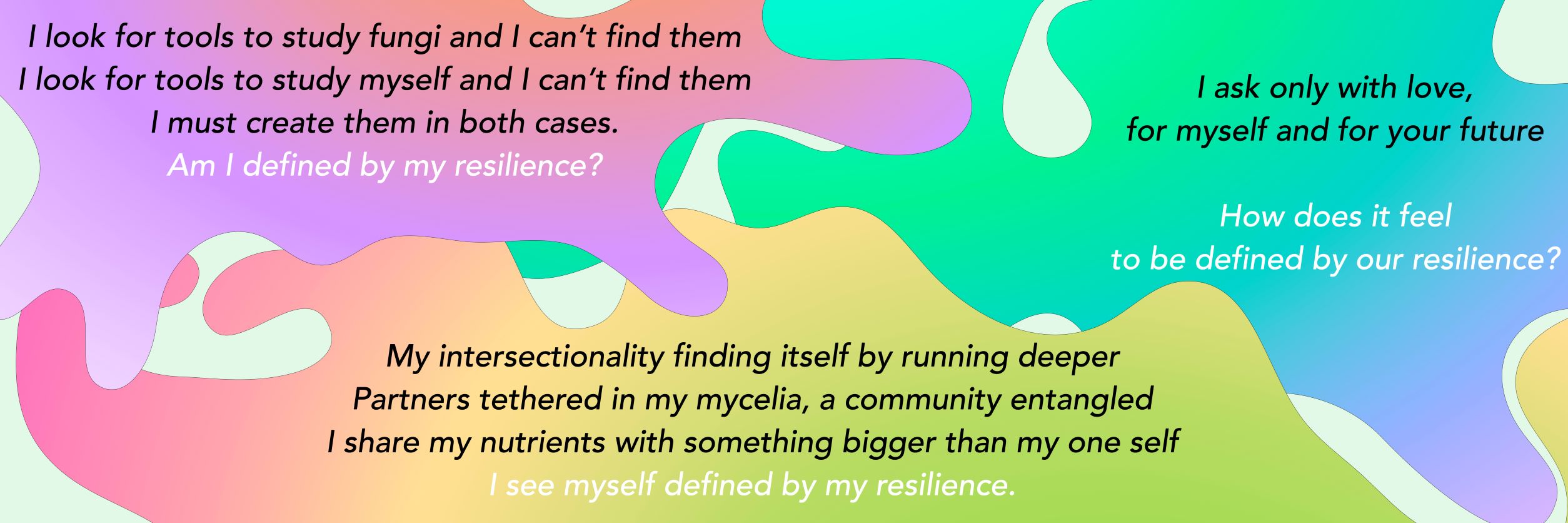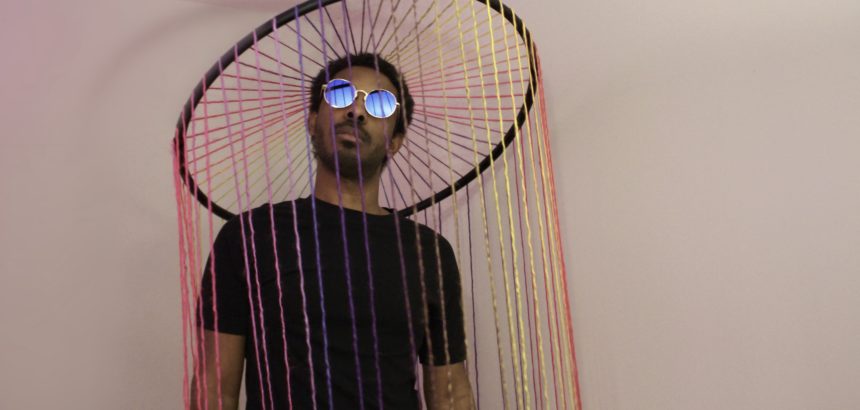In a time when most people want nothing more to do with microorganisms involved in death, the 2022 Rhubarb Festival boldly ushers them to share a stage with their performers. Andrea Shin Ling’s ‘Calculus of an infinite rot, part 1’ functions as a microscopic vehicle for us to converse with these incredibly big feelings.
As a queer synthetic mycologist, ‘Calculus’ tells me an additional story that extends beyond these thematic intentions. I see it both through its fungal (de)composition and the implicitly queer, experimental space it intentionally occupies. It uncovers a glimpse of the harmony between mycology (the study of fungi) and the shared queer cultural experience. A harmony that defies the binarized world-view that has been conditioned into so many of us.
I’m currently a Ph.D student that studies the genetics of fungal pathogens and I’m drawn to the process of morphogenesis, which is an ability that allows certain fungi to change their shape at the molecular level. And as a queer person, it was clear that the fluidity that fungi are able to embody were reflective of my own experiences of wanting to change and find new shapes that I’m comfortable in. Granted my research isn’t in finding the intersection between the fungi I study and my queer identity, I still want to use this space to ideate on these feelings.
To do this, I explore within the framework presented in Patricia Kaishian and Hasmik Djoulakian’s recent publication that brings the parallels between mycology and queer culture into brilliant and undeniable light. I won’t attempt to recreate their work (because really you should just >>read<< it for yourself), but rather I want to explore my own thoughts on how fungi and queer culture experience eachother.

Before I make my own alignment of these two concepts, it’s worth establishing a foundation. Queerness often transcends definition in an attempt to be as encompassing as possible, while also masterfully avoiding its own deconstruction. To me queerness is an identity unified by both its self-creation and its intentional separation from the heteronormative baselines that underpin the fabric of global society. And it is through this self-creation and evasion of established baselines, that fungi experience the greatest paralells with queer culture. Fungi, those weird elongated yeasts or textured tree symbiotes, had to create their own way of being understood. Birthing itself out of the rejection of trinary plant-animal-bacterial classifications, mycology was born from the idea that fungi stand on their own.
Beyond connecting these concepts through their definitions, mycology to me just feels really queer; insofar as even trained microbiologists don’t fully understand fungi and often avoid them all together. Just last week I had a meeting for a project in which a group of undergraduate students are trying to engineer a fungus to enhance its production of plant nutrients and biopesticides. Now what’s cool about this fungus — beyond its ability to protect and grow with plants — is that it can undergo morphogenesis and is known as dimorphic. Dimorphic fungi fluidly change their shape, often going from a small yeast cell to an elongated cell about 10 times its original size. However, one of the lead professors told the students to forgo the idea of using a fungus entirely, and use a bacterium instead so they wouldn’t have to worry about it changing its shape.
As someone who studies dimorphic fungi, this interaction silenced my excitement. It reminded me of being a seven year old child all over again and my mother taking away my super cool, neon pink Powerpuff Girls school bag, only to give me a gross, blue Tweety Bird one. And I remember knowing that the reason I liked my original bag was the same reason that she didn’t. I remember how hard she worked, not to make me like the new blue bag, but to make me hate my old pink one. I could highlight many other lessons of quelled excitement, from dresses to haircuts to even BlackBerry phone cases. But anyone who is BIPOC and queer already knows, with great intimacy, the stories and fights we had with our parents as kids. What I didn’t see as a kid was the conservative societal reality behind her motivation. I didn’t see how her actions were based in fear and the wish for me to adhere to binary social rules just to make my life “easier”.
Now as an adult sitting in this zoom call with the professor, I felt their fear motivating the project change to focus on bacteria. Fear of the project failing because the students wanted to explore an organism that we don’t fully control. It’s the same fear that lets academia describe microbiology mainly using bacteria and actively results in most colleges and universities having a significant underrepresentation of fungal courses. For the sake of productive research, fungi, similar to the experiences of queer youth, are often left behind. There is disappointment in their nonconformity, and their exploration is often actively discouraged.

Additionally, common to queerness and mycology is the boundary-pushing societal influence these concepts share, and the threat they face under hyperconsumerist and heteronormative systems of control. Often we perpetuate the westernised school of thought that ascribes value only to that which we can extract benefit from. In the case of mushrooms, society tends to frame their benefit to us from a medical or social standpoint. We care only about the ones that we can forage on, have psychedelic experiences with or extract new compounds from; the ones that we want to relate to. But mycologists themselves are still in a state of exploration, with some still discovering fungal diversity and others trying to understand the true nature of the fungi we know.
Queer culture is also facing the reality of its simultaneous self discovery and current commodification on its journey toward societal integration. Similar to fungi, culture is also consumed, but the way it’s processed and the outcomes of this consumption can be problematic. Queer culture, as intrinsically expressive as it is, becomes an influential tool that allows members of our community to feel safe and relate to each other more deeply. However, it is often co-opted, misconstrued and unacknowledged in wider society as mainstream media and its creators try to find new ways to reinvent themselves. We see this in the continued discrimination against BIPOC queer bodies against the backdrop of westernized cherry picking of ‘trendy’ queer slang, spaces and artistry.
Ultimately, framing the true impacts of both queer culture and mycology must be an intentional practice done by its members, highlighting our unique existence, experiences, and communities at its forefront. Look, I really could go on. And if you want to know more, Mycology as a Queer Discipline offers a much deeper dive into the connection between these two concepts, with a great ethics of care and a well-recorded historical basis for their ideas.
In both queerness and mycology, we demonstrate that finding kinship where you least expect it continues to make for a wonderful symbiosis. We find ways to tell our stories, explore our journeys and see parts of ourselves in weird, sometimes experimental metaphors. And what is Rhubarb, if not a place for us to experiment with new ways of being, new methods of expressing our collective experiences. The biological subversion explored in ‘Calculus of an infinite rot, part 1’ as queer performers find renewed artistry is more than just exciting; it feels right.
This year’s festival tells me that, while queerness may be something that is expressed and mycology may be something that is examined, they are both concepts whose accurate perception relies not on validating their inherent nature, but rather empathetically experiencing them.
Tying a culture to a scientific field isn’t commonly done, especially by someone who spends about 50 hours a week at a benchtop. However, thank you Clayton and Andrea for giving me a chance to breathe even more life into the emergent parallels between two concepts that only just started spending time together.



I want to hear more about gay mushrooms!! Love this exploration!